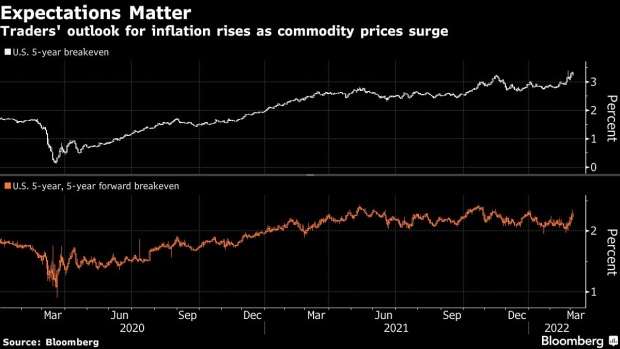Mar 4, 2022
Bond Traders Track Oil as Rising Inflation Bets Muddy Fed’s Job
, Bloomberg News

(Bloomberg) -- Bond traders have a new obsession: the cost of oil and gasoline.
That’s because commodity prices -- especially what consumers pay at the pump -- make up an outsized component of inflation expectations, which have been mounting ever higher as Russia’s war in Ukraine intensifies.
It’s on the radar of strategists as well as the Federal Reserve, with the central bank set to raise rates this month to combat multidecade-high actual inflation. Economists have long felt that expectations can ultimately exacerbate actual price pressures, with consumer perceptions affected in an outsized way by the cost of a fill-up.
The five-year Treasury breakeven inflation rate -- or the spread between yields on nominal Treasuries and those adjusted for inflation -- is trading near its highest since at least 2002, when Bloomberg began compiling the data. Even longer-run measures have risen after the step up of sanctions on Russia worsened the outlook for price pressures. Oil traded near $117 on Thursday and has gained nearly 50% this year and 55% in 2021.
“Oil and gas prices play an outsized role in shaping the inflation expectations of global investors, business and consumers,” said Mark Zandi, chief economist at Moody’s Analytics. “If high inflation expectations persist” it becomes harder for the “Fed to shake those expectations.”
Fed Chairman Jerome Powell was asked during a Congressional appearance this week how sanctions and the war overall could affect the central bank’s ability to fight inflation.
“The risk is that inflation expectations will start reacting in a way that is negative for controlling inflation,” Powell said. The persistence of a oil spike is also key, and a general rule of thumb is that each $10 bump higher in oil prices lifts actual inflation by two-tenths of a percentage point -- while dimming economic growth by half as much, he said.
Next week’s reading on the consumer price index is top of mind for bond traders after the metric climbed an annualized 7.5% in January and is forecast to have bumped to 7.9% in February. Breakevens are priced off CPI, which on average runs about 40 basis points over the Fed’s preferred measure, which was 6.1% in January.
Five-year breakeven rates briefly edged lower on Friday in the wake of a labor-market reading that showed average hourly earnings were unchanged from the prior month. Rates went on to rise as oil and commodity gains picked up pace. The five-year rate traded at 3.3%, up about 3 basis points.
Rising prices of other commodities that Russia supplies, such as potash and palladium, also pose “additional risks to inflation expectations, which have rebounded significantly post-pandemic,” said Priya Misra, global head of rates strategy at TD Securities Inc. And “sticker-price shocks on gasoline prices tend to have a more lasting effect on consumer inflation expectations.”
According to AAA, the national average price of gasoline on Friday was $3.837, compared with $2.745 a year ago.
‘Energy Shock’
Strategists at Societe Generale SA warned clients Thursday that there’s “prospect of a massive energy shock” and that U.S. investors should be long inflation breakevens. “The potential for higher inflation and lower growth complicates the policy reaction function,” the strategists wrote in the note.
Increases in commodity prices should be “continuing for quite some time and probably quite significantly,” said Randy Kroszner, economics professor at the University of Chicago Booth School of Business and former Fed governor.
“The Fed has to worry about that because people are asking to get paid more -- reasonably enough, because everything is costing a lot more,” he said Friday on Bloomberg TV. “If that gets baked in -- and they just expect to get high wage increases -- that’s really difficult for the Fed to peel back.”
Last June, just months before the Fed pivoted its policy to a more hawkish stance, D.E. Shaw & Co.’s Brian Sack cited rising inflation expectations as a reason why the Fed should move to signaling plans to remove accommodation. He’s the former head of monetary and financial market analysis at the Fed Board of Governors who helped convince the central bank to use a 5-year, 5-year forward breakeven rate to guide policy.
Zandi at Moody’s said that if five-year inflation expectations held consistently in the 3%-3.5% range, then actual inflation will likely be centered in that area within six to 18 months irregardless of what economic forces would otherwise dictate.
©2022 Bloomberg L.P.


